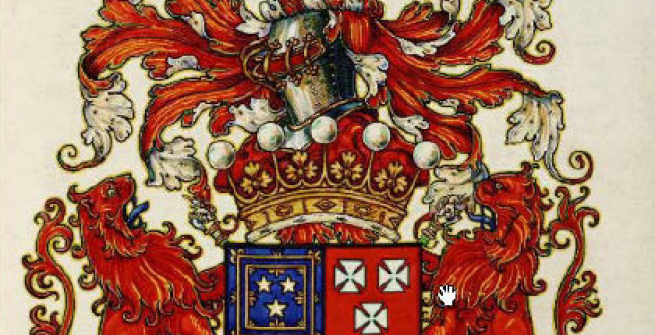I recently completed an online heraldry class conducted by the University of Strathclyde, and I learned a great deal that will be helpful to me as a genealogy librarian.
Heraldry is the study of armorial bearings, otherwise generally known as coats of arms. Coats of arms were originally designed to identify warriors on the battlefield (so you didn't accidentally chop off a head you didn't want to chop off) but rapidly went on to become symbolic representations of a specific family (therefore, the association with genealogy). The earliest known decorated shield that used "hereditary devices centered on the shield" is the one Henry I of England gave his son-in-law, Geoffrey of Anjou, when he knighted him in 1127.
Many different countries have taken part in granting official arms to specific individuals, and sometimes, the arms can be hereditary (passed down to direct heirs—either "intact" or exhibiting a "difference"). I bring this up because I'm often asked at the reference desk to help patrons find their coats of arms. However, because the rules of inheritance are not universal, I have to tactfully respond to the person asking that he/she is probably not entitled to a coat of arms (so hold off on getting that tattoo!).
However, I may be able to find a coat of arms that belonged to one of the person's ancestors. It's tricky, though—each country has different rules and different resources relating to the official arms it has granted. And even within the country, it can be rough (for instance, there are 36 "Campbells" in the 1904 Scottish Armorial Seals by Macdonald and two entire volumes of "Garcias" in Garcia Carraffa's Enciclopedia Heraldica y Genealogica Hispano-Americana collection).
One thing my class impressed upon me is that heraldry has its own language. Most people have seen an artistic depiction of arms (see the illustration at the top of this blog post), but you might not know there is also always a verbal description. This verbal description is called a "blazon," and it was a helpful tool when printing illustrations was not as easy (nor cheap) as it is now. It serves as a precise written blueprint for an artist to follow when executing an illustration of the arms.
Within the blazon, all of the items of the "achievement" (the complete armorial depiction) must be described. One will encounter metals and tinctures and furs (i.e. colors), ordinaries and sub-ordinaries (simple geometric shapes), beasts (animals and monsters, in a variety of poses), other charges (castles, acorns, savages, anything!), lines of division (separating the components), patterning of the field (background design), and items around the shield: mantling, a helmet, a crest, supporters, etc. And each of these has a certain way it should be described in how it is situated on the shield or in the achievement.
A simple shield like one of the arms for the country of France (a blue shield with three gold fleurs-de-lis) would be blazoned as "Azure, three fleurs-de-lis Or." There are a zillion rules that I can't fit into the space of this brief blog, but, in essence, this blazon follows the rules that the color of the shield comes first (written in Norman French, although some say some of the names of the colors come from a Persian root), then the main charge(s) followed by their color.
A blazon for a complicated achievement, however, is really something to behold. The blazon for the illustration at the top of this blog is:
Quarterly, 1st and 4th, Azure, three mullets within a double tressure flory counter-flory Or; 2nd and 3rd, Gules, three crosses patee Argent. In the saltire behind the Shield, two scepters Vert, each capped with a unicorn rampant armed Gold, protruding below base a chaplet Proper supporting the official badge. Above the Escutcheon is placed His Lordship's coronet, thereon a Helmet befitting his degree with a Mantling Gules doubled Ermine; on a wreath Argent and Gules is set for Crest a stag's head couped proper langued Gules with a cross Patee Argent between the antlers; in an Escrol over the same this Motto Spero Meliora. On a Compartment of grass are set for Supporters two lions salient Gules, armed and langued Azure.
As you can imagine, it can be a methodical unraveling to decipher what the above actually looks like, never mind figuring out to whom the coat of arms has been matriculated. One tool to use for this latter challenge is an "ordinary," which is a book organized alphabetically by the primary charges on the shield. The example above is for Alan David Murray, Earl of Mansfield, which you might find if you look under "mullet" (a star, not a bad haircut) in an ordinary.
If I haven't scared you off, there's a great book to help you learn the ins and outs that are more enjoyable to read than you'd think: Boutell's Heraldry, by Charles Boutell. Also, a juvenile-level book that can give you a nice overview is Simple Heraldry, by Iain "Moncreiffe of that Ilk."
I would like to design my own coat of arms someday, something perhaps involving a capybara and a squirrel rampant. The American College of Heraldry (established in 1972 and currently chartered as a non-profit corporate body by the State of Alabama) is not as discriminating (shall we say) as the illustrious heraldic authorities across the Atlantic, and they will register a Coat of Arms of your own making for just $325. Now all I have to do is come up with a fitting motto, and then I can get that tattoo!
